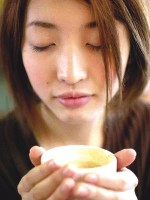|
Culture
The Tao of Tea
Yasmin Lee
 The world of tea is filled with other colours, aroma and flavours beyond green and black Drinking tea is considered a social activity in Taiwan so it did not come as a surprise when Wang Lien Yuan, owner of Youji Mingcha, ushered me inside his shop with a friendly gesture and invited me to a free taste of his tea. The world of tea is filled with other colours, aroma and flavours beyond green and black Drinking tea is considered a social activity in Taiwan so it did not come as a surprise when Wang Lien Yuan, owner of Youji Mingcha, ushered me inside his shop with a friendly gesture and invited me to a free taste of his tea.
“You don't have to buy anything,” he tells me. Youji Mingcha is a tea shop that specialises in Chi Chong Oolong tea made from the tea leaves grown in the mountains of northern Taiwan. I have been a tea drinker for years now but my knowledge about the kinds of tea is limited. Wang confirms this. “Most people only know green or black tea,” he says.
I was literally dizzy at the selection of tea in his shop when it came to choosing what I wanted to taste. I wanted to taste everything, but not wanting to abuse my taste buds (and Wang's hospitality), I settled for High Mountain Oolong tea, Jasmine tea and the shop's speciality, Chi Chong Oolong tea. Wang's 22-year-old son who helps him in the shop patiently explained to me the differences of each kind of tea.
High Mountain comes from tea leaves grown over 1,000 metre-high mountains and nourished by the year-round cloud mists. Oriental Beauty (dongfang meiren), also known as “boasting tea” or “champagne oolong tea” usually represents Taiwan in the global market. For this kind, the whiter the tea sprouts, the higher the grade and it tastes sweeter and has a fruity aroma.
As we waited for the water to boil, Wang gave me a tour of his factory at the back of his shop. Two men were manually sorting tea leaves. Loose-leaf tea is of higher quality than those already pre-packed into teabags, which is considered low quality. Of course the former is more expensive and at Wang's shop, ranges from NT$160 (US$5) to NT$2,400 ($73) depending on the gram.
Tea was big a industry in Taiwan 100 years ago, Wang says, and used to account for 50 per cent of the island's exports. Wang is a fourth-generation tea connoisseur. His great grandfather Wang Jing Hwei started the business in the early 1900s; the shop and the factory have since passed through three other generations. His only son will eventually take over when he is old enough and has started to learn the ropes.
“Tea was treated as a medicine in the old days,” Wang notes. “Now, it is more of a social activity. We can sit around here and talk the afternoon off.”
He adds that any kind of tea is good for one's health. Tea, as others would say, is the yin to coffee's yang. We sat down around a table at the front of the shop. Wang's wife joins us as he holds court, serving the brewed concoction in traditional small tea cups.
He explains that each type of tea requires a different time for steeping. “Some tea tastes stronger or bitter when baked longer,” he explains as he drains the teapot into a cup and then pours the light-coloured brew into a smaller cup.
Tea should be brewed by time, not the resulting colour of the brew. Black tea is steeped from three to seven minutes, oolong from one to four minutes and green tea from two to three minutes. Youji Mingcha is located in Dadaocheng, an area in Taipei where the tea industry has flourished since the early days.
Meanwhile, in the southeastern part of Taipei, up in the hills, is the tea-growing region of Maokong. Maokong is famous for tieguanyin, an oolong variety, that grows on the terraced farms along the hillside. Maokong's tea farms has become accessible with the July launch of the Maokong Gondola, an extension of Taipei's MRT. The 30-minute cable ride from Taipei Zoo MRT station makes four stops along the way (Taipei Zoo South and Zhinan Temple and two pass-by stations) and ends at Maokong. The entire ride is 4.03 kilometres with the highest point at 299.4 metres.
Teahouses line the road from the Maokong station where one can taste the local brews while enjoying the scenery. The long walk from the station has primed me for a fresh pot of tea and I finally found a teahouse that proclaimed: “well tea, well food, well view”.
The view was not bad indeed; from where I sat sipping oolong tea, I could see the Maokong cable cars ascending or descending against a backdrop of green hills. In the distance, Taipei 101 stood vaguely in the distant fog.
First published in the Asian News Network. Reprinted with permission.
Copyright
(R) thedailystar.net 2007 |
